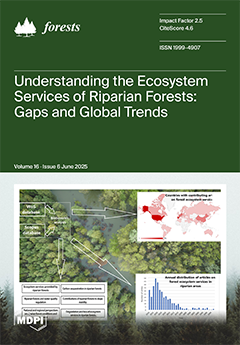Understanding the processes of organic nitrogen (N) mineralization to ammonium (NH
4+) and NH
4+ oxidation to nitrate (NO
3−), which, together, supply soil inorganic N (the sum of NH
4+ and NO
3−), is of great significance for guiding the restoration of degraded ecosystems. This study used space-for-time substitution to investigate the dynamic changes in the rates of organic N mineralization (
MNorg) and nitrification (
ONH4) in soil at different vegetation restoration stages. Soil samples were collected from grassland (3–5 years), shrub-grassland (7–8 years), early-stage shrubland (15–20 years), late-stage shrubland (30–35 years), early-stage woodland (45–50 years), and late-stage woodland (70–80 years) in the subtropical karst region of China during the dry (December) and rainy (July) seasons. The
MNorg and
ONH4 were determined using the
15N labeling technique. The soil microbial community was determined using the phospholipid fatty acid method. Soil organic carbon (SOC), total nitrogen (TN), NH
4+, NO
3−, and inorganic N contents, as well as the soil moisture content (SMC) were also measured. Our results showed that SOC and TN contents, and the SMC, as well as microbial community abundances increased markedly from grassland to the late-stage shrubland. Especially in the late-stage shrubland, the abundance of the total microbial community, bacteria, fungi, actinomycetes, and AMF in soil was significantly higher than other restoration stages. These results indicate that vegetation restoration significantly increased soil nutrient content and microbial community abundance. From grassland to the late-stage shrubland, the soil NH
4+, NO
3−, and inorganic N contents increased significantly, and the NH
4+:NO
3− ratios changed from greater than 1 to less than 1, indicating that vegetation restoration significantly influenced soil inorganic N content and composition. As restoration progressed, the
MNorg and
ONH4 increased significantly, from 0.04 to 3.01 mg N kg
−1 d
−1 and 0.35 to 2.48 mg N kg
−1 d
−1 in the dry season, and from 3.26 to 7.20 mg N kg
−1 d
−1 and 1.47 to 10.7 mg N kg
−1 d
−1 in the rainy season. At the same vegetation restoration stage, the
MNorg and
ONH4 in the rainy season were markedly higher than those in the dry season. These results indicate that vegetation restoration and seasonal variations could significantly influence
MNorg and
ONH4. Correlation analysis showed that the increase in
MNorg during vegetation restoration was mainly attributed to the increase in SOC and TN contents, as well as the total microbial community, bacterial, fungal, actinomycetes, and AMF abundances, and that the increase in
ONH4 was mainly attributed to the increase in
MNorg and the decrease in the F: B ratio. Moreover, the
MNorg and
ONH4 showed a strong positive correlation with inorganic N content. This study clarifies that vegetation restoration in karst regions could significantly increase
MNorg and
ONH4 through enhancing soil carbon and N contents, as well as microbial community abundances, thereby increasing the available soil N supply, which could provide a theoretical basis for soil fertility regulation in future rocky desertification management.
Full article





